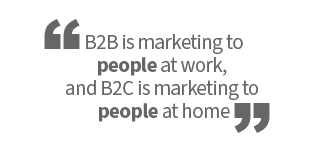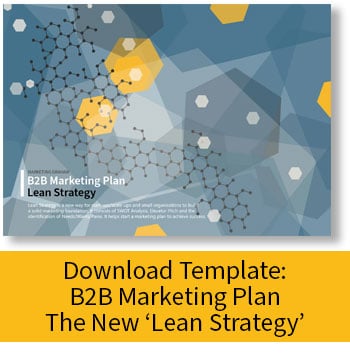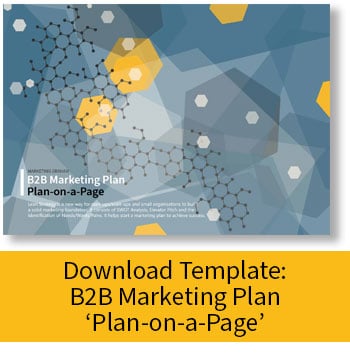I’m occasionally asked “What is B2B Marketing?”. I’ve always thought the answer was obvious. But now I’ve set myself the task of putting it in writing I realise that modern B2B marketing is complex, and now inherits some features from its B2C cousin.
Let’s get the acronyms out of the way; B2B stand for Business-to-Business, and B2C means Business-to-Consumer. Done.
Next, who am I am I trying to help with this article? If you are a junior marketing exec or a newly promoted Head of Marketing at a small organisation, this is for you.

Traditionally I’ve described B2B as marketing to an organisation, and B2C as marketing to consumers. That now seems slightly outdated.
My new definition is that B2B is marketing to people at work, and B2C is marketing to people at home. Notice the subtle difference?
The reason for the difference will become clear as I outline my opinion on how to do B2B marketing successfully.
Start by developing a B2B Marketing Plan
Building and writing a marketing plan or strategy can take months if you are the only person in the marketing department, especially if you follow the guidelines of the Chartered Institute of Marketing.
Often strategies and plans are written for enterprise companies with big marketing departments and a budget to match. You probably don’t have the time and may not have the resources.
The good news is that I’ve developed a set of tools that consists of a Lean Strategy and Plan-on-a-Page. These will give you a slimline B2B Marketing Plan and route to success. Here goes.
Step One: Your Lean Strategy
You can download my Lean Strategy template and complete all the boxes.
The strategy consists of SWOT analysis which should identify areas for improvement (so you offer the very best proposition), but also your main advantages.
Next, you’ll need to identify the Needs, Wants & Pains of your audience. This should help you effectively satisfy your customers’ desires.
And finally, you’ll create an Elevator Pitch. It ensures everyone in your company gives the same answer to the questions “What does your company do?” and “Why should I use your company?”
Step Two: Your Target Markets & People
Your Lean Strategy should help you identify your target audience; which territories, industries or sectors, and job titles. This helps you develop an ideal ‘buyer persona’ so you can identify good sales leads.
This stage will include the development of your database of target companies and contacts. Good data is critical. Don’t rush it or pass it to a junior member of staff; take responsibility for quality data.
Quality data is a never-ending task. You need to continually add, refresh and cleanse your data. It can be boring but extremely worthwhile.
Step Three: Your Tactics and Channels
Now you need to establish where your target audience congregates and how to reach them. This should include questions like:
What questions are they asking on search engines?
Are they seeking solutions that nobody currently provides?
Where do they spend their time online?
What industry events do they attend?
What job titles are in the typical buying team?
Some of the questions can be answered by analysing existing customer data and some will require new research, surveys or focus groups with prospects.
The most effective channels I’ve used are listed below, but you will need to create your own multi-channel programmes and campaigns based on your target audience.
But remember, just because a marketing channel is popular does not mean it’s effective.
Search
The good news is that 60% of traffic to the average website comes from search engines*, the bad news is if you are not on page one of the results you are dead.
Part of your research should be to find the keywords and phrases your audience enters into search engines. You then need to ensure your website ranks well on those phrases.
Google will probably account for 80% of your search traffic, and since 2020 Google has prioritised the mobile phone version of websites. More on that in my article ‘How Google’s new ‘mobile-first’ policy reduces your website traffic‘.
Email response rates have been falling for over a decade, but the low cost means it is still an effective channel. Average response rates for B2B campaigns are likely to be 15.1% open rate** and 3.2% click rate**, but this will vary widely depending on your industry/sector.
Spend time on your email Subject line and test alternatives to ensure you get the optimum response. Also, test emails on mobile devices to ensure the text is legible and don’t assume that all your images will be downloaded. Always create a plain text alternative as some email security systems don’t allow HTML emails from unknown sources, and beware ‘false-positive’*** opens and clicks.
There is some debate about whether LinkedIn is a job board or social media platform, either way, it’s a great B2B channel – but it’s expensive.
I’ve had great success with the Sponsored InMail feature, sending ‘mail’ messages to highly targeted audiences. You can expect an average open rate of 57.5%** and 3.6% click rate** (but I’ve had highly targeted InMail campaigns achieve 72% open rate and 12% click).
Sponsored Content (posts and videos) on LinkedIn have been less successful – I’ve seen people quote an average click rate of 3%, I’m getting between 0.2% and 4.5% clicks.
Retargeting on LinkedIn is a great way to nurture sales leads. It enables you to display digital adverts to people that have visited your website. Click rates may not be high, but it’s all about keeping your name front-of-mind until they are ready to buy.
Voice marketing
I was going to call this section ‘telemarketing’, but if I did that you may have skipped over it. More fool you because telemarketing is still one of the most powerful tools in the B2B arsenal.
I’m not talking about cold calling (although that has its place), I’m talking about having a one-to-one conversation via video or phone with a person that has engaged with your organisation.
If you think that tele/voice marketing is old-fashioned and out of date, then critically analyse your existing customers and see if you had a remote voice conversation with them before they became a customer. You may be surprised.
Social Media
Social media as a research tool is great, you can gather a lot of valuable information (especially from LinkedIn) about your target buyers. As a lead generation tool, I remain to be convinced.
Don’t fall into the trap of believing that social media is free. Yes, you don’t need to pay to set up a Twitter, LinkedIn or YouTube account, but the amount of time you spend on these platforms is not free – your salary is a cost.
In addition, all the established social media platforms are now monetising their service. Organic reach is low and getting lower. If you want to reach your target audience in substantial numbers you have to pay to boost your posts or videos.
Events/Webinars
During the coronavirus pandemic, face-to-face events were cancelled and webinars replaced them. Either channel is a great way to demonstrate your product to a wide audience – and their attendance qualifies them as a warm lead.
If you are doing a webinar, respect the attendees’ time and don’t waffle. The content needs to teach them something they don’t already know, this is not a sales opportunity but a learning experience.
Keep it to 20 minutes plus 10 minutes to answer any questions. The most successful webinars I have organised have been in association with another group or person – for example, an industry expert or relevant membership organisation.
Step Four: Create Assets and Campaigns
This is often the fun part of B2B marketing, creating adverts, videos, podcasts or exhibition stands. You can let your creative juices flow.
Traditionally, the message on these assets was designed to appeal to the rational thinking of buyers – quoting facts and figures to prove the value of a product.
But more and more marketers are adding emotional messages to their B2B marketing, especially through story-telling. This is where B2B is adopting some of the techniques used in B2C marketing.
An early example of emotional messaging from the 1970s is IBM’s great tagline “Nobody ever got fired for buying IBM”.
Including both rational and emotional messages in your marketing should ensure it appeals to a wider audience.
Step Five: Test and Learn
Testing should be a big part of all marketing, especially growth hacking. But it’s important to be confident about your test results. See my article on A:B split tests ‘How to test your marketing ideas and check the results are valid‘.
To decide what is worth testing I always begin by understanding what is on my audience’s mind. Tools like Wordtracker, Ahrefs, Semrush and Google Search Console highlight the popular words and phrases people use to arrive at my website and the subjects I should be writing about.
This helps to give me ideas for content I can use in email marketing, digital adverts and webinars.
Each platform (MailChimp, Google Ads, LinkedIn, etc.) will show response figures, so it’s easy to identify which A:B split test got the best results. If you are spending money on Google Ads I highly recommend using Google Optimise to test alternative messages. But to add further intelligence you will need to analyse your Google Analytics figures (learn more in my article ‘5 tips: Google Analytics for beginners‘). Make sure you set goals for your website. For example, the number of ‘Book a Demo’ forms completed or the number of App downloads.
Step Six: Be an industry expert
You have experts within your organisation (if you don’t, hire some!), and their opinion and expertise will be of value to your audience. This is Content Marketing.
Thought-leadership helps to set you apart from your rivals, giving your audience expert advice for free and positioning you as a generous company that ‘knows their stuff’.
The difficulty (and I can’t believe I’m writing this) is the experts, including CEOs, are sometimes reluctant to publish their advice.
Often they claim not to have the time and occasionally they are shy in front of the camera. My solution is for you to be the expert. Start writing blogs, producing videos and hosting webinars to show your colleagues how easy it is.
Content marketing is a huge subject and I cannot do it justice here, so please take a look at two of my articles; ‘5 tips: A practical guide to content marketing‘ and ‘Copy my content marketing strategy that delivers results‘.
The final stage
To help abbreviate all of this into an easily digestible format I have created a Plan-on-a-Page. A single A4 sheet with all the key metrics and statements for you to share with C-level execs and your team. You can download the Plan-on-a-Page template and fill in the blanks.
* Source: Growth Badger
** Source: LinkedIn Sponsored InMail Overview
*** False-Positives: Many organisations are using security bots to check emails before they are delivered. The bots open and click any links in the emails, giving a false impression that humans have interacted.
Note: The click rate is the percentage of successfully delivered messages that got at least 1 click.
Get my latest blog posts, reports and videos delivered straight to your Inbox, just 8 times a year. It’s free but not cheap. Complete the form below to receive the Marketing Graham Bulletin; you can unsubscribe at any time.
| Marketing Graham Bulletin |
|---|
Photo by Jon Tyson


